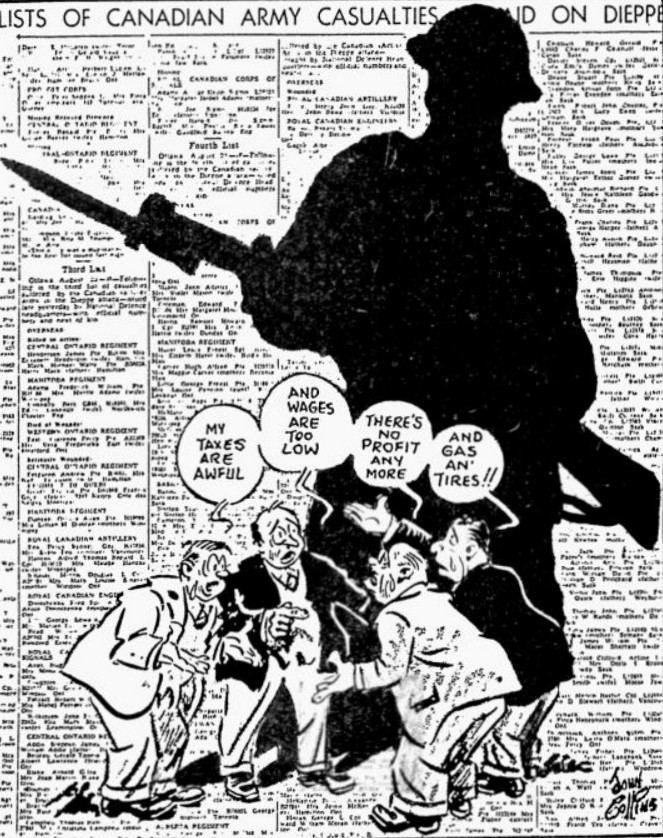The Gazette (August 24, 1942)
BRIGADIER W. W. SOUTHAM, LEADER OF DIEPPE LANDING, IS PRISONER, NAZIS REPORT
Was first ashore
Tank-carrying barge hit by shell just after he left it
Roberts’ craft hit
Headquarters destroyer hit by Nazi bomber during raid; casualties now 418
London, England (CP Cable) – (Aug. 23)
Brig. W. W. Southam of Toronto, whose capture by the enemy at Dieppe was reported tonight by DNB, the German news agency, directed the man Canadian attack on the town from start to finish.
A Reuters News Agency dispatch from the continent quoted the German news agency DNB as announcing that Brig. Southam was taken prisoner in last week’s raid on Dieppe.
DNB was quoted as saying that 105 officers were taken prisoner, including two colonels and 14 staff officers.
He landed on the beach at Dieppe under fierce fire and remained in wireless communication with the force headquarters of Maj. Gen. J. H. Roberts of Kingston, Ontario, throughout the battle.
The brigadier went onto the beach in a tank-landing craft with assault troops at dawn. All the tanks were landed from his craft and as he was about to go down the side, he shouted to the men behind him:
All right, boys, here we go. We’ll see this thing through.
Just then, a shell burst inside the craft, causing some casualties but Brig. Southam pushed on. Some of his staff reached him on the beach later and they got behind the seawall on the western end of the beach held by the Royal Hamilton Light Infantry.
Used car wireless
The brigadier’s wireless set was set up but he found a scout car belonging to the Calgary Tank Regiment with a strong wireless set and he opened communications with force headquarters with this set.
Maj. Arthur Fraser of Ottawa, who was aboard the force-headquarters destroyer, said:
His voice was exceedingly cheerful throughout. There wasn’t a quaver in it and occasionally he would make some wisecrack. He was the same old boy through it all.
We kept in contact with the brigadier all the time and between one and two o’clock he sent a message saying he could see some troops surrounded and out of ammunition down the beach and they were surrendering.
It is believed that Brig. Southam firmly established his headquarters in the Casino at the west end of the beach.
Brig. Sherwood Lett of Vancouver was also scheduled to go ashore and establish another headquarters but he couldn’t make it. He was in a tank-landing craft that touched on the beach but it was hit several times by shells and machine-gun fire that prevented anyone from getting out.
The craft was literally blown off the beach and the same thing happened when another attempt was made to land. Brig. Lett was evacuated and brought back to England. He is now in hospital.
Brig. Southam, a member of the noted Canadian publishing family, was appointed last Jan, 15 to command a brigade of the Canadian Army Overseas and was promoted from lieutenant colonel to brigadier. He had previously been office commanding the 48th Highlanders of Canada, a Toronto unit.
The 40-year-old soldier is a son of the late Richard Southam of Toronto. He joined the 48th in 1922 after his graduation from Royal Military College. He reached the rank of major in 1939 and, six months later, became second in command when the battalion was mobilized for active service.
In Sept. 1940, he was appointed commander of the battalion and promoted lieutenant colonel.
Before the war, Brig. Southam was vice president and managing director of Southam Press, Toronto, Ltd. In 1924, he was married to Dorothy Rodgers of Toronto. They have three daughters.
The destroyer used by Maj. Gen. John H. Roberts of Kingston, Ontario, as headquarters from which he directed the raid on Dieppe was hit several times by Nazi bombers, it was disclosed tonight.
Gen. Roberts directed the raid by wireless signals from the cabin of the destroyer’s captain and the bridge. The vessel cruised up and down before Dieppe during the operation and sometimes it was only a few hundred yards off shore.
It was under fire from German shore batteries as well as German planes.
Casualties stand at 418
Ottawa (CP) – (Aug. 23)
National Defence Headquarters tonight released the fifth Army casualty list since the battle of Dieppe and it contained the names of 183 men, 182 of them wounded and one “wounded and missing.”
This brought the total casualties reported since the battle to 418. An official count of the lists shows 79 killed, 313 wounded and 26 missing. These totals are subject to a margin of error because of possible duplication of names in succeeding lists.
The total number of men reported killed and missing by the Army since the start of the war now stands at 872.
